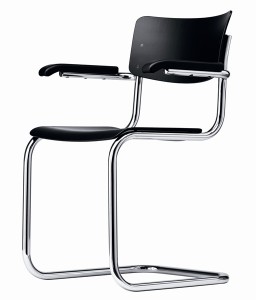
We're just a touch late with this one, but since July 22nd the Martin Gropius Bau in Berlin has been showing the exhibition "Bauhaus. A Conceptual Model".
For the first time, the three German Bauhaus institutions - Bauhaus-Archiv Berlin, Museum für Gestaltung, Stiftung Bauhaus Dessau and Klassik Stiftung Weimar - are uniting to present a comprehensive Bauhaus retrospective. “Bauhaus. A Conceptual Model” recounts the story of the Bauhaus in a comprehensive presentation of the works of its masters and students - including a number of lesser known and not regularly displayed works. In addition the exhibition looks at principles that dominated the school and it's work: inter-disciplinary, experimental teaching, the concept of practice-oriented workshops, the pursuit of answers to social questions, the propagation of timeless aesthetics as well as experimentation with new procedures and materials in architecture and design.

Few movements have left such a lasting impression on furniture design as Bauhaus from it's short inter-war intermezzo.
Designs such as Mart Stams cantilever chair, the Bauhaus Lamp from Wilhelm Wagenfeld or the „Wassily“ chair by Marcel Breuer stand as testament to the quality and ingenuity of those involved. In addition popular (smow) products such as the Eiermann table frame or the new Eileen Gray range from ClassiCon have their roots firmly in Bauhaus and the approach to design and functionality that was developed there.

We've not seen “Bauhaus. A Conceptual Model” , however for the organisers "the early works of the Bauhaus masters are highlights. They document why Feininger, Klee, Kandinsky et al were summoned to the school as masters. Works by masters and students created during their sojourn at the Bauhus demonstrate the fast-paced creative development of the school. Among other objects, the “Gropius Folder” can be seen, which was presented to the director of the Bauhaus as a birthday gift in 1924. The visitor will be amazed by the “African Chair”, created and constructed by Marcel Breuer and the weaving artist Gunta Stölzl in 1921. For eighty years it was assumed to have been lost, and is quite contradictory to Breuer’s wide reputation as the designer of the steel tube furniture. Breuer’s first “Club chair” from 1926 can also be seen, as well as Johannes Itten’s four-metre-high “Tower of Fire” from 1920. The “Draft of a socialist city” by Reinhold Rossig and the “Bauhaus Dress” by Lis Vogler from 1928 are exemplary representatives of the unknown works that originated in the workshops."
Which sounds fantastic
If your in or near Berlin, Germany the exhibition “Bauhaus. A Conceptual Model” runs until October 4 and is open daily. More information at http://www.modell-bauhaus.de/